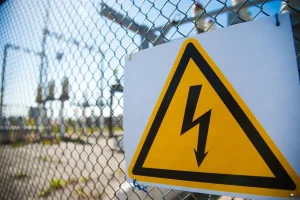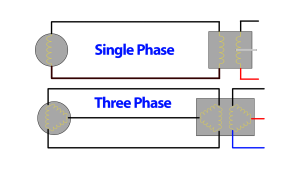Multiple Ways a Person Can Get Electrocuted vs Shocked
Many apprentice electricians are, understandably, scared to work on live electrical circuits. Mostly because they don’t understand the fundamentals of how current flows between two points. When a person understands how electric shock occurs, it can remove the fear and give the person a more informed understanding of the environment they’re working in. It is still better to air on the side of caution when working on live circuits. But if fear is the basis an electrician operates from it often means they don’t fully understand what they’re doing. This article will introduce multiple ways a current can flow through a human body. Not sure what the difference is between Electrocution and being shocked? Check out “Electrocution vs Shock: Understanding the Differences“.
Energized Conductors
The first way a person can be electrocuted vs shocked, is through direct contact with an energized termination, conductor, or piece of equipment. This is one of the most common scenarios for electrocution (electrical death). Many people try to work on their own lighting, receptacles, breakers, and appliances and forget to turn the power off before doing so. When they go to work on the equipment they often don’t think about what they’re touching, or where other parts of their bodies are touching when they interact with the conductors.
Let’s look at, perhaps, a silly example – but something that could realistically happen on a jobsite. If, for example, a metal ladder is leaning against a metal beam that connects to the grounding electrode system, and therefore bonded to the system neutral. This means the ladder is most-likely conductive and exists at the same potential as the grounding system and grounded neutral conductor. This ladder is, in essence, a grounding conductor.
Now let’s say an electrician is standing next to a metal ladder and leaning on it with their bare arm. Now the electrician’s entire body is the grounded conductor. If the electrician reaches out to touch a live energized conductor they will receive a shock, as current flows through their body, through their arm, through the ladder, through the beam, back to the main bonding jumper, up the service-entrance neutral, and back to the transformer. It is because the electrician is completing the circuit with their body.
If you fully isolate the ladder from the building steel with electrical insulating rubber, or if you use a non-conductive ladder like fiberglass, the current can no longer take a conductive path back to the service. In this case the electrician could theoretically touch the live conductor. Even if leaning on the ladder, and no current will flow through them. They aren’t between two conductive objects within the circuit. Therefore there’s no way to complete the circuit with this person’s body.
Now – it must be said – don’t ever do this. Don’t touch live conductors with your bare hands, period. Especially don’t be so unaware that you’re leaning against something conductive and touch an energized conductor. The entire scenario above shows irresponsibility, and you should avoid attempting it. This is just a theoretical example, to illustrate a point. It’s also important to understand that higher voltages and higher currents can pass through insulation easier. This includes air and fiberglass ladders. Therefore, its even more crucial to remove all hazards of electrical shock in higher voltage environments. This is why we follow the working space requirements of Article 110.26 of the NEC. As well as the PPE guidelines and limited and restricted approach boundaries laid out in the NFPA 70E when working on energized circuits and equipment.
Energized Outlets
Another similar way people get shocked is at electrical outlets such as receptacle outlets or lighting outlets. If a person screws in or unscrews a lightbulb while a light switch is on and they allow their fingers to get inside the socket, they can get shocked when they touch both the screw shell and the bottom pin of the light socket at the same time. Remember, current only flows between two different potentials. So if they only touched one of these things, they would not have been shocked. (Assuming they weren’t also barefoot or on a metal ladder or touching something else made of metal).
Current always travels in loops, from one potential to another. This means that wherever there exists a difference of potential (a voltage). For example, between a hot and a neutral, connecting the two will create a path for current to travel between them. With a lightbulb your finger becomes the filament if it touches both the hot pin and the neutral screw shell at the same time.

Source – powertec.ca
Plugging In or Unplugging Cords
Many people have been shocked when plugging or unplugging cords into receptacle outlets. Such as vacuum cleaners and extension cords. To get shocked, the current needs to use you as a path to get from the source back to the source. Touching a single energized object is not going to shock you until you connect to another object that is at a different potential.
Many people have touched their fingers to both prongs of a plug when inserting it into a receptacle. In this case, your finger completes the circuit between the hot and neutral prongs (or the hot and ground prongs) of the plug when you insert it into the receptacle. If you don’t connect two different points of potential, you wont get a shock. But if you touch both points of a potential difference, current will flow through that part of your body to get from one potential to the other.
Presence of Water
One unexpected way a lot of people have been shocked is through working with faulty extension cords in wet environments. Say an electrician is drilling holes through wooden studs with a corded hole-hawg that has a damaged plug at the end of the cord. In this case let’s assume the ground prong has broken off. Making it so the tool no longer has a connection to the equipment grounding conductor of the receptacle the cord plugs into.
Let’s exacerbate the situation by making the environment wet from a recent rain. Making the entire slab, being exposed to the rain, is wet with pooled up water. As the electrician keeps dragging the tool around through puddles the entire cord becomes wet. Water covers everything the electrician touches, making their hands and the tool wet. Every once in awhile when they pull the trigger of the hole-hawg, they receive a shock through their hands. But when they let go of the trigger they’re ok.
There are a couple of factors at play here. First it’s important to note that, since there is no ground connection the only way current can flow is through the hot and neutral. We require GFCI protection on jobsite temporary power stations to avoid this situation. But for our example let’s say it was never installed. Current is flowing through the conductors inside the cord, through the tool’s motor, and through the water-soaked metal parts around the tool and through the person’s hands. The person is likely being shocked because everything is saturated. The metal that should be grounded, is not grounded – instead it’s just a large conductor. When the tool’s trigger closes, the entire circuit closes allowing current to flow through the tool.
Since everything is wet inside the tool, and outside of it, current follows the path of the water around the metal casing and through the person’s hands. Whatever path the water is taking to get to their hands, they become a parallel branch of the circuit with the tool. This happens because water saturates everything, and water conducts electricity. When the trigger is let go of, the entire circuit opens and they don’t get shocked anymore.
Current doesn’t take the path of least resistance in a circuit, contrary to popular belief and it’s incorrect. Current takes all conductive paths available to it to complete a circuit. In a parallel circuit current will take all branches, and will flow in proportion to the amount of resistance available in each path.
Always remember that wet skin offers lower resistance to current flow compared to dry skin. People can be badly injured if they get shocked when they’re wet. This is why we require electricians to install GFCI protection on receptacles in wet locations. When current flows somewhere it shouldn’t it creates an imbalance between the hot and neutral terminals of the receptacle. Which immediately triggers the GFCI to trip and protect from shock. Working in wet environments, with wet tools, and wet hands is a dangerous situation. Always be cautious around electricity and water, especially if there’s not proper GFCI protection on the circuit.

Faults
Another type of shock can occur from a condition that we consider a “fault”. There are two types of faults, a ground-fault, and an arc-fault. One example of a ground fault happens when an energized conductor breaks free inside of a metal appliance, then touches the metal casing of the appliance. It could energize the entire metal frame/casing of the appliance if proper grounding is not in place which would otherwise have tripped the breaker. “Clearing a fault” is a phrase we use to talk about a breaker tripping in response to a fault condition. If the breaker doesn’t trip, the circuit stays (dangerously) in this fault condition.
In this example, if a person were to walk up and touch the appliance with their hand while standing barefoot on a concrete floor, current could travel from the metal casing, through their entire body, into the concrete and possibly injure them badly. Remember that current cannot travel if it doesn’t have two different potentials to travel between. If the person had insulated boots on, they could touch the energized metal of the appliance and not get electrocuted. This is because there are not two distinctly different points of potential for current to flow through. This shows the importance of wearing proper PPE when working on live electrical circuits.
Energized Circuits Near Wet Soil
A common way electricians experience unexpected shocks is by kneeling on saturated soil while working on a live circuit in front of them. Many electricians who repair street lighting, or parking lot poles are familiar with this. Once you grab an energized conductor while kneeling down in wet soil, current has a way to travel between the conductor in your hands and another potential (the earth). This is another case where simply turning the circuit off before-hand is smarter. Or if it is absolutely unavoidable, at least wear electrically insulated rubberized gloves (and other PPE in accordance with NFPA 70E) when handling energized conductors.
Arcing
Yet another way that people become part of an electric circuit is through arcing components, devices, or appliances. We call unintentional arcing in a circuit, an arc-fault. A series arc-fault is an arc that happens at a loose termination, or in-series in the circuit. A parallel arc-fault occurs between two hot conductors, a hot and a neutral, or a hot and a ground (in parallel in the circuit). Arc-faults can cause fires when they occur near flammable materials. An arc can also reach through the air and find a different potential to travel through if given the right amount of voltage and a low enough resistance. A loose screw or conductor, or worn insulation between conductors, can cause arcing in an appliance.

Cutting Through Conductors
We sometimes hear tragic news stories where people die while cutting live conductors in attempts to steal copper and resell it at a metal scrapyard. What these people don’t realize is that cutting the conductors can introduce them to the circuit and cause a massive amount of current to flow through their bodies, which can kill them instantly.
Cutting through a single conductor is safe and often done by electricians working on live circuits. The problem occurs if the conductor bounces around and hits other things after the cut. Or if a person’s hands/body touches the conductive end and another conductive surface. But a lot of times people try cutting multiple conductors together. Whether it is simply a piece of 12/2 NM cable being cut all the way through, or two massive conductors coming down an electrical pole into an underground conduit – cutting through parallel conductors, such as a hot and neutral or two hots, will result in an explosion at the cutting point.
The reason for this is that the tool’s cutting surface is metal (a conductor). When it makes contact with two current-carrying conductors it shorts the two conductors together. When this happens an incredible amount of current flows through the circuit. Since there’s no longer the resistance of a load slowing the current flow. The weakest termination point for this energy to be released is the place where the tool is making touch-contact with the conductors, so it will vaporize the metal of the tool (and the conductors) at the same time and blast away from this point. If these conductors are small 20-ampere conductors that are hundreds of feet long the available fault current is not as great.
Most likely the person cutting will just see a bright flash, hear a loud pop, and find that they need to buy a new set of pliers. If these conductors are 500kcmil conductors 20 feet away from the transformer this will be a much more violent and explosive event. We could be talking about the difference between 250A flowing and 250,000A flowing during this short-circuit.
Arc Flash/Arc Blast
Arc-flashing is another type of unintended and violent contact with an electrical circuit. During an arc flash, there is so much energy from a single point in an electrical circuit that it can create a fireball that can fill an entire room. So much heat can build up in a split second that it will literally turn solid metal into vapor. It’s so intense it skips liquification and goes straight to the next form of matter – a gas! The speed and intensity of an arc flash can send a wave of intense thermal energy blasting outward. Which can cause serious injury or can kill someone standing nearby.
Flash suits help to minimize the damage done during an event like this. Not only are they thermally protective and fire resistant, but are electrically insulating and cover the entire body of the wearer. Many have protective visors to protect the face. It’s also standard to wear boots and electrically insulating “hot gloves”. This is to ensure there is no skin exposure at all during an arc flash.

Static Shocks
A simple way that a person can get shocked is through static discharge. Charges can build up between two objects, creating a difference of potential between them; effectively creating a capacitor. The amount of energy released during a discharge between two objects is quite large for such a small form-factor. Extrapolate this to a larger scale and we have lightning from clouds to earth.
Static shocks are much smaller and more surprising than anything, usually experienced after a build-up of friction. A body can build up an excess of electric charge relative to, say, a metal doorknob. When a person’s finger get’s close enough to the door knob that the air becomes a conductor for the flow of charge an arc travels between the finger and the doorknob. In this scenario the two opposite charges are trying to return to equilibrium and balance out the distribution of charge when the two objects contact one another. Remember, current can only travel between two different potentials. If there’s no buildup of charge between two different objects, a static discharge will not occur.
Lightning
If lightning strikes near your house during a storm, not only can it damage the electrical components in a system. It can travel along any metal water piping or other metal grids/structures in the ground. This could also electrocute a person who may be touching connected metal in or near a structure. When lightning strikes, it seeks low impedance paths to the ground. While the primary route may be the object it directly strikes. There is immense energy within a lightning bolt can spread out and follow various secondary paths.
High-Voltage Line Grounded
If a high-voltage line falls and comes into contact with the ground, it can create a voltage gradient in the nearby area due to the difference in soil consistency in an area. This means that there could be a difference in the electric potential between two points on the ground. Even between two points as close as the distance between your feet. If you were to step in this area, your body might complete the electric circuit. This allows current to flow through you with possibly life-threatening consequences. This phenomenon, called ‘step potential,’ closely resembles ‘touch potential’ from a normal shock.
To visualize step potential better, imagine a scenario where a lightning strike or a fault in the electrical substation creates an “electrically charged” zone on the ground. If you were to step into this zone, different parts of your body could come into contact with areas having different electric potentials. This would allow electricity to flow through your body seeking to equalize the potential difference. This is what leads to electric shocks.
Utility companies train their employees to use specific techniques to get out of situations like this. This includes dragging their feet or shuffling without lifting their feet off the ground. In turn minimizing the risk of electric shock in areas where there might be a dangerous voltage gradient between the steps they take. By dragging or shuffling your feet, you maintain a more consistent contact with the ground. Which helps minimize the potential difference between your feet and thereby reducing the risk of electric shock. It essentially ensures that the points of contact with the ground (the feet) are at nearly the same electric potential. Therefore, minimizing creating any difference of potential (voltage) between the person’s feet.
How Easy It Is to Get Hurt
The effects of electric shock on the human body can vary greatly depending on a variety of factors. This includes the duration of the exposure, the pathway the electricity takes through the body, and individual physiological differences. 20mA of current traveling through a person is enough to damage skin tissue. This is 0.02 Amperes, which is a very small amount of current. 200mA (0.2 A) is enough to cause ventricular fibrillation, a serious kind of heart arrhythmia that can be life-threatening. Anything above this threshold is enough to cause such strong muscle contraction that a heart may stop. Causing a person to go into cardiac arrest and potentially cause serious burns to skin tissue. This is not even 1 Ampere of current.
Conclusion
As you can see, there are many ways a person can suffer injuries when dealing with electricity. It’s not only high current traveling through a person’s heart that is dangerous. Even small amounts of current traveling through your body can seriously injure, or possibly kill you. This stuff is no joke. There are people out there with scars all over their bodies from having to get skin grafts to repair burns they’ve suffered from introducing their bodies to a circuit. So please, be very careful working on electrical circuits. Don’t work live unless you have proper training on how to do so.








